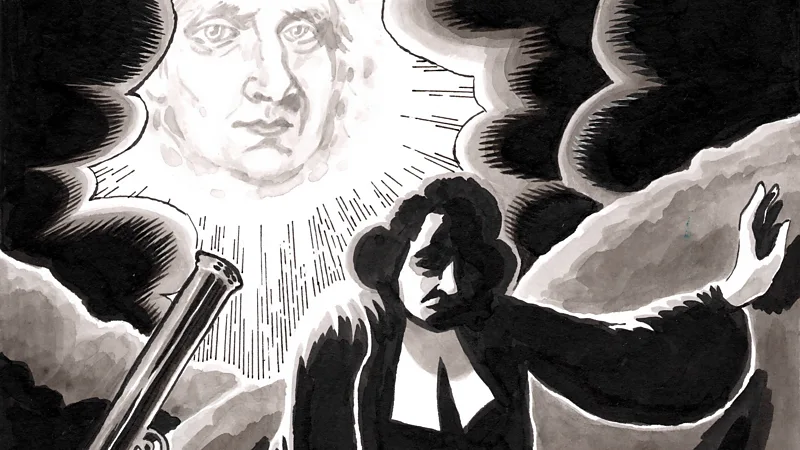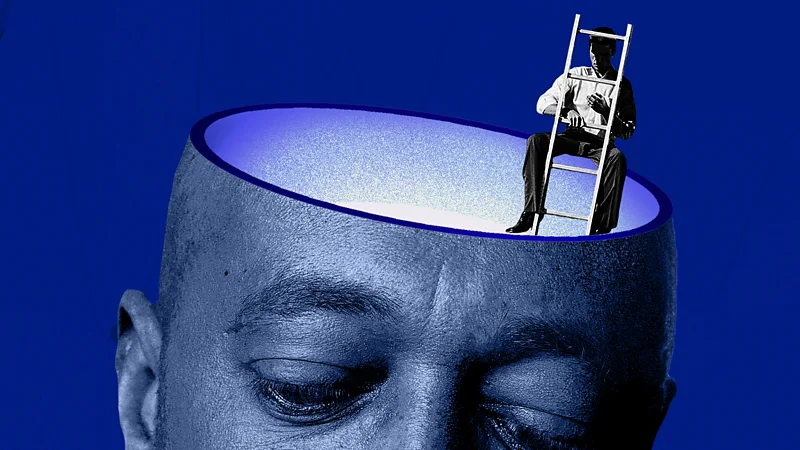The forgotten priest who predicted black holes – in 1783
Almost 200 years before scientists accepted black holes exist, a British clergyman called John Michell published some surprisingly prescient ideas about these strange cosmic objects. Why isn't his work better known?

The existence of black holes is a bewildering thought, especially in light of the idea that billions of them could populate the cosmos. For decades in the 20th Century, eminent physicists refused to believe they could be real, ignoring what the mathematics predicted. These doubters even included Albert Einstein – whose own theory of general relativity made black holes possible (see "Why Einstein and his peers were 'irrationally resistant' to black holes".)
However, there was one person who showed remarkable prescience about black holes – and did so long before Einstein was even born. Using only Newtonian laws, a little-known British clergyman called John Michell anticipated these astronomically strange objects in some important and surprising ways, all the way back in the 18th Century. Who was Michell, what did he predict, and why were his ideas mostly forgotten?
Michell was born in 1724 in the village of Eakring, England, the son of Gilbert Michell, the parish rector, and his wife Obedience Gerrard. Educated at home alongside his younger brother and sister, John had an early reputation for quick learning and perceptiveness. According to the historian Russell McCormmach, his father Gilbert enjoyed quoting a family friend who described John as "the clearest head he had ever met with". Gilbert valued independence of thought, describing himself as "not attached to any body or denomination of men in the world". The family followed latitudinarian Christianity – a tradition that venerated reason over excessive doctrine and that had originated at the University of Cambridge under Isaac Newton. So, when the time came for John to enter university, it was Cambridge he went to.
With a plentiful supply of coffee houses, and an intimate community of just 400 students, the university was an ideal setting for intellectual discourse. Michell stayed there for more than 20 years in various posts, studying and teaching across disciplines including Hebrew, Greek, arithmetic, theology and geology. He was a committed experimentalist and, as another biographer Archibald Geikie puts it, "fond of constructing his own apparatus... His rooms at Queens' [college] with all his implements and machinery would sometimes wear the look of a workshop". It was also during his Cambridge years that he began to show his capacity for scientific foresight.
In 1750, he published a paper on magnetism, introducing at least one entirely new law – the "inverse square law" – that furthered the application of magnets in navigation. In 1760, he published a paper on the mechanics of earthquakes, describing the stratified layers of the Earth now known to comprise its "crust" and demonstrating how earthquakes move through these layers in the form of waves. He also showed a way of estimating the epicentre and focus of the catastrophic Lisbon earthquake of 1755 and explored the idea that submarine earthquakes could cause tsunamis.
Michell also published a paper on the mechanics of earthquakes, which showed a way to estimate epicentres and explored the idea that quakes could produce tsunamis
After leaving Cambridge in 1764, he married Sarah Williamson and moved to Thornhill in Yorkshire to follow in his father's footsteps as a parish rector. Sarah died the following year and Michell was married again to Ann Brecknock in 1773. Alongside his work in the church, he maintained correspondence with various other natural philosophers and intellectuals of the period, including the American polymath Benjamin Franklin.
From a 21st-Century perspective, the idea of an employee of the Christian church being at the heart of scientific life might seem surprising. But, like most 18th-Century intellectuals, Michell would not have made the distinction between religion and science. The introduction of telescopes in the early 1600s had caused a great philosophical upheaval across Europe. The fixed, observable hierarchy of God's creation – the Earth and heavens – had been overthrown by what science historian Alexandre Koyré calls an "indefinite and even infinite Universe" that had to be understood through observation of "its fundamental components and laws". But for thinkers like Michell, this revolution did not displace God, it simply renewed his mystery: the natural laws under investigation were still God's laws.
As Newton had written in 1704, "Our duty towards [God], as well as that towards one another, will appear to us by the light of Nature." It was this Newtonian Christianity Michell followed. As McCormmach puts it, "the truths of his religion were in agreement with the truths of nature". So, alongside his parish duties, Michell gradually focussed his attention on cosmology and in particular the nature of gravity. This was the domain in which he would produce work that was both revolutionary and prophetic, even long after his own death.
Michell built his own 3m (10ft) reflecting telescope and, in 1767, he was the first to apply the new mathematical methods of statistics to the study of visible stars, demonstrating that clusters like the Pleiadies could not be explained by random distribution and must be a consequence of gravitational attraction.
In 1783, Michell's friend Henry Cavendish wrote to him mentioning some difficulty Michell was having with the construction of a new, even larger telescope. "If your health does not allow you to go on with that," he wrote, "I hope it may at least permit the easier and less laborious employment of weighing the world". This sounds like a joke, and perhaps it was meant to be funny, but Cavendish was referring to a real endeavour.
Michell had been working on a torsion balance, a device that would allow him to estimate the density of planet Earth through measuring the gravitational attraction between lead weights. Michell died before he could make use of the apparatus but after his death it passed to Cavendish who conducted the experiment in 1797. He calculated the density of the Earth to within 1% of the value now accepted. The accuracy of Cavendish's result was not exceeded until 1895, and a variation on Michell's apparatus is still used today in measuring the gravitational constant – the strength of gravitational attraction that operates throughout the Universe.
Black hole foresight
The same year as Cavendish's letter, Michell published a paper containing a hypothesis that, though it was to prove less scientifically durable, was perhaps his most brilliant in its perceptiveness. Using Newtonian principles, it started by explaining how the density of stars could be established by observing the way their gravitation affected other nearby bodies, for example the orbits of other stars or comets. Michell then went on to discuss how the behaviour of light could be used to similar ends:
"Let us now suppose the particles of light to be attracted in the same manner as all other bodies with which we are acquainted... of which there can be no reasonable doubt, gravitation being, as far as we know, or have any reason to believe, an universal law of nature."
Light would escape from such a star but, as Michell explained, "would be made to return towards it, by its own proper gravity"
The particulate or "corpuscular" theory of light had been proposed by Isaac Newton some 80 years earlier and, though nobody had been able to demonstrate it, it remained the dominant belief in Michell's day. Michell explained how the behaviour of light under gravity could offer a way of calculating the density of stars, at least hypothetically, especially if a star was "large enough sensibly to affect the velocity of the light issuing from it". Though current understanding is that he was wrong about gravity's impact on light speed (it isn't slowed), his reasoning was sound.
By the same principles, Michell deduced – correctly this time – that it was also possible that the gravity of the most massive astral bodies might overpower their own light rays entirely. For a star to achieve this, it would need to be the same density as the Sun and about 500 times its size. Light would initially escape from such a star, perhaps making its way out to nearby orbiting planets but, Michell explained, "would be made to return towards it, by its own proper gravity".
Since the light of such a star could not arrive at us, "we could have no information from sight" but we might still be able to detect it from irregularities in the orbits of other nearby astral bodies caused by the gravity of the invisible star, "which would not be easily explicable on any other hypothesis".
These speculations, Michell explained, were "somewhat beside my present purpose", but they contain perhaps the closest approximation to the idea of black holes possible under Newtonian physics, not to mention an outline of a working method for identifying them. Several black holes have been detected via the orbits of neighbouring stars in just the way Michell suggested. It is only in the last few years that telescopic images have confirmed the indirect evidence.
Black holes vs scientists
Why did Einstein and other prominent physicists resist the possibility of black holes for so long? In this special illustrated feature, BBC.com explores why these strange and sublime cosmic entities were so difficult to accept.
According to McCormmach, the existence of invisible stars was a relatively common idea among scientists of the time. The same year Michell published his paper, several other astronomers were corresponding about stars that had become extinct. In 1805, the astronomer Edward Pigott published a paper suggesting the likelihood of stars "that have never shewn a glimpse of brightness." While their true number could never be known, "would it then be too daring or visionary to suppose their numbers equal to those endowed with light?" he asked. In France, the polymath Pierre-Simon Laplace promoted the idea of dark stars independently of Michell during the late 1790s.
Not long after this, however, new experiments lent strength to the idea that light is composed of waves rather than massy particles and the suggestion that it could be deformed or trapped by gravity began to fall out of fashion. Michell's astronomical work fell into obscurity and was only rediscovered during the second half of the 20th Century.
In his 1994 book Black Holes and Time Warps, the physicist Kip Thorne describes the "marked contrast" between the enthusiasm with which Michell and his contemporaries embraced the idea of gravitationally invisible stars and the "widespread and almost universal 20th-Century resistance to black holes". The crucial difference, he concludes, is that Michell's dark stars, though exotic, "were no threat to any cherished beliefs about nature", and no challenge to "the permanence and stability of matter". As McCormmach points out, modern black holes, by contrast, are precisely that: "a puncture in space-time, an infinite well from which nothing can escape". Despite this, McCormach speculates that Michell, "who acknowledged 'the infinite variety which we find in the works of the creation', would have no problem with our black holes." There's no way to test this claim but, given Michell's extraordinary scientific imagination, as well as his commitment to the Newtonian tradition of reason, it does seem an attractive one.
Michell died on 21 April 1793 at age 68 having remained rector at Thornhill to the end. Other intellectuals of his period were – and are – much better known. They published more frequently and on subjects that were more popular. Michell, by contrast, followed his nose. In McCormmach's words, he "took up scientific problems as they interested him, in whichever field, and he pursued them as far as he wished and no further; and he published his work if and when he wanted to, and only when he was fully satisfied with it". This goes some way to explaining his obscurity after death – he sacrificed impact and renown in the name of intellectual freedom.
As the Alexandrian astronomer Ibn al-Haytham had observed 700 years before Newton, the "seeker after the truth" is not one who puts his trust in authorities, "but rather the one who suspects his faith in them... one who submits to argument and demonstration". Following in this tradition, Michell, like his father, was an autodidact, protecting his scientific integrity by remaining unattached to any "body or denomination of men".
Michell's independence allowed him another freedom essential to original thought: that of imagination. According to McCormmach, he chose astronomy specifically because it offered new vistas for theory. In his passion for scientific imagination, Michell anticipated the creativity of theoretical physicists today. As Einstein put it in 1929, "imagination encircles the world."
-bbc







